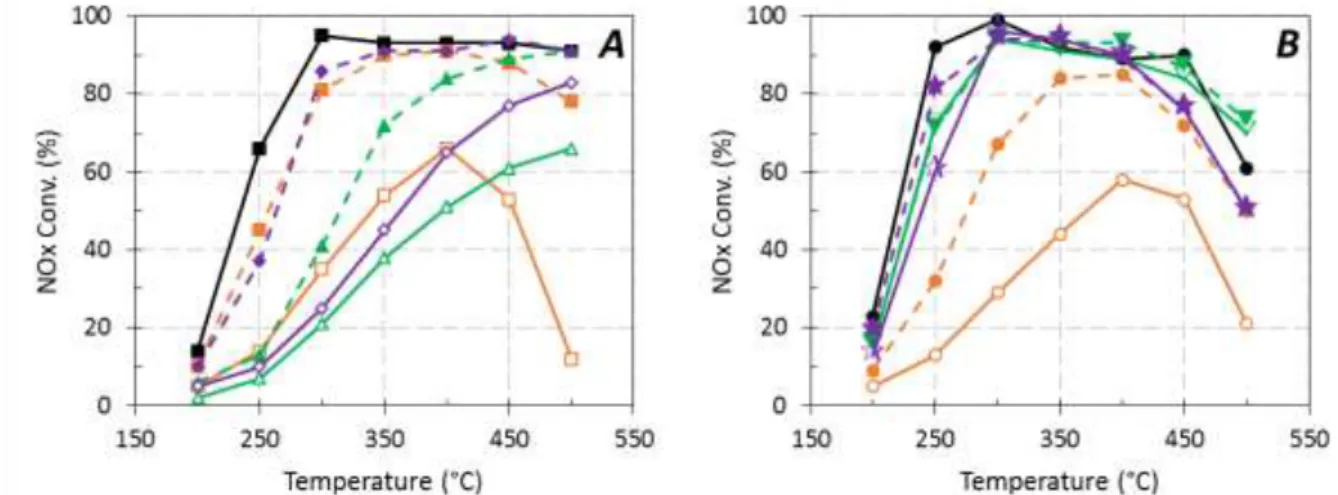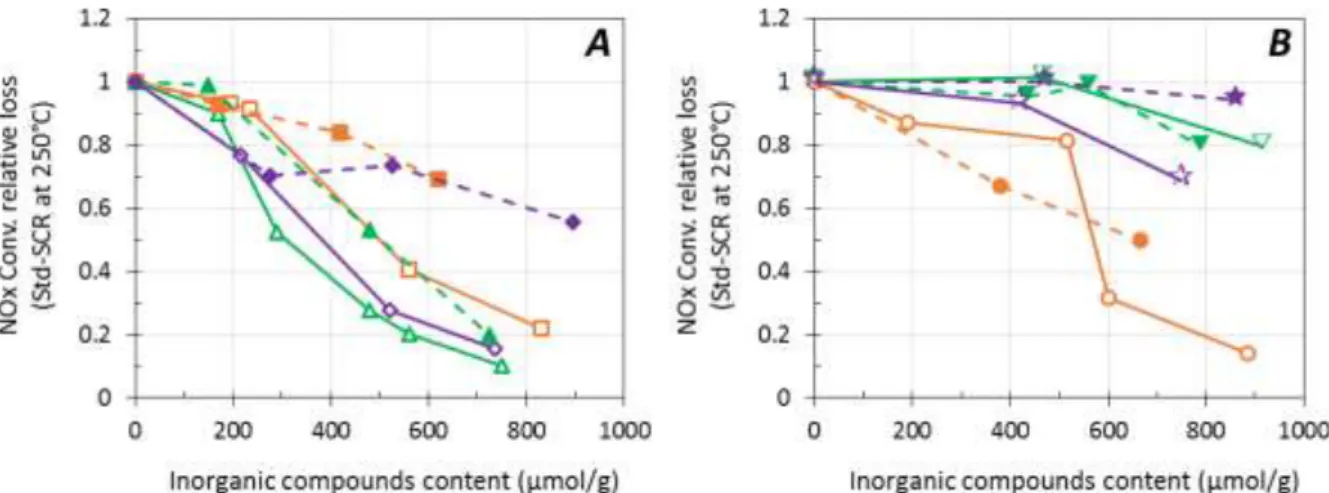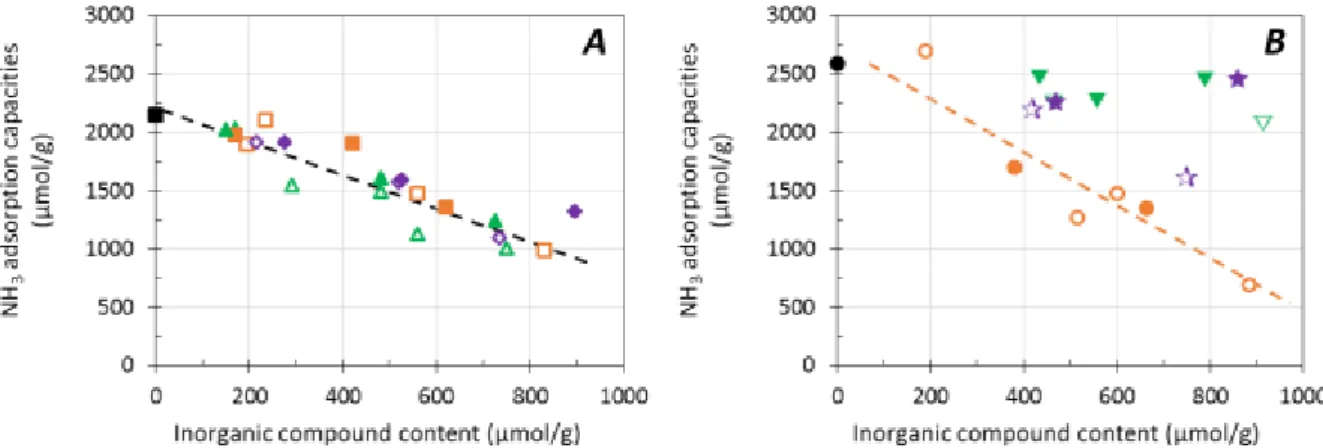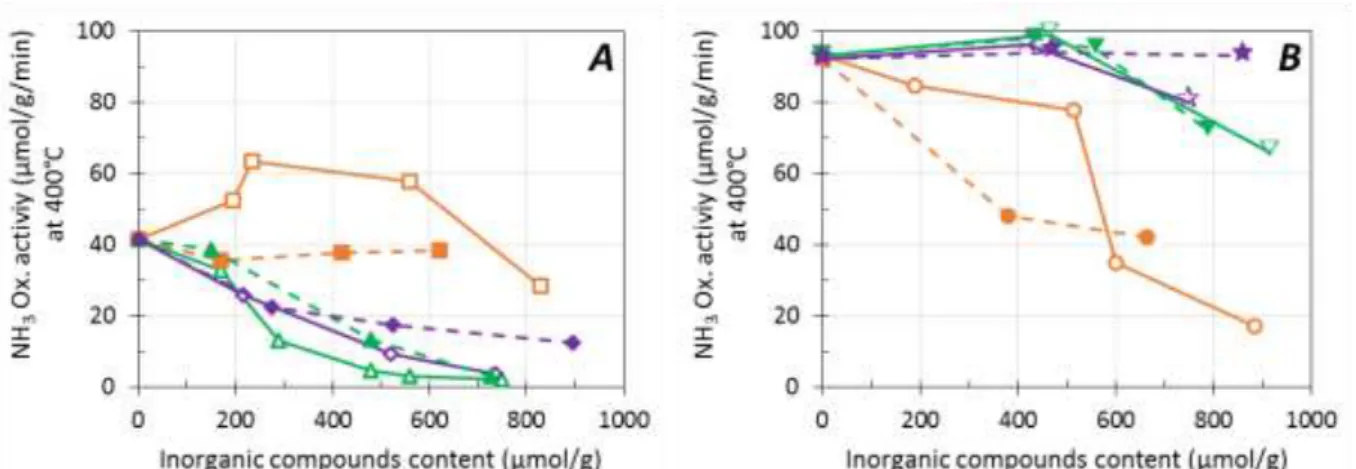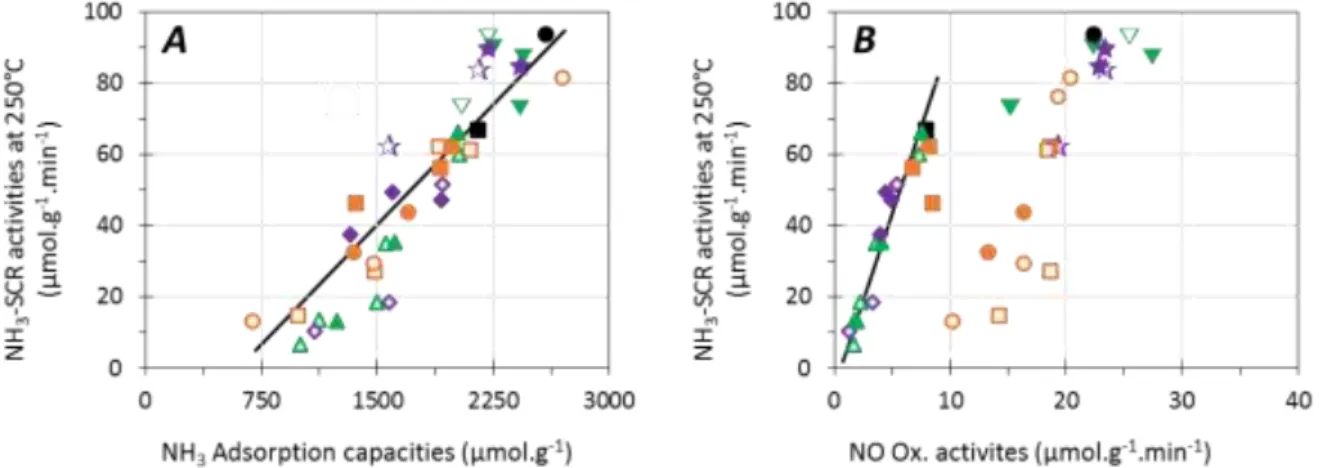HAL Id: hal-03108692
https://hal.archives-ouvertes.fr/hal-03108692
Submitted on 13 Jan 2021
HAL is a multi-disciplinary open access
archive for the deposit and dissemination of
sci-entific research documents, whether they are
pub-lished or not. The documents may come from
teaching and research institutions in France or
abroad, or from public or private research centers.
L’archive ouverte pluridisciplinaire HAL, est
destinée au dépôt et à la diffusion de documents
scientifiques de niveau recherche, publiés ou non,
émanant des établissements d’enseignement et de
recherche français ou étrangers, des laboratoires
publics ou privés.
Influence of Sodium and/or Phosphorus Addition on the
Deactivation of Cu-FER Zeolites for SCR of NOx with
NH3
M-L Tarot, F. Can, E. Iojoiu, V. Lauga, Xavier Courtois
To cite this version:
M-L Tarot, F. Can, E. Iojoiu, V. Lauga, Xavier Courtois. Influence of Sodium and/or Phosphorus
Addition on the Deactivation of Cu-FER Zeolites for SCR of NOx with NH3. Topics in Catalysis,
Springer Verlag, 2018, 62 (1-4), pp.72 - 78. �10.1007/s11244-018-1117-9�. �hal-03108692�
1
Topics in Catalysis 62 (2019) 72–78
DOI: 10.1007/s11244-018-1117-9
Influence of sodium and/or phosphorus addition on the deactivation of Cu-FER zeolites for SCR of NOx with NH3.
M-L Tarot1, F. Can1*, E. Iojoiu2, V. Lauga2, X. Courtois1*
1IC2MP (UMR 7285), Université de Poitiers 4 rue Michel Brunet, 86073 Poitiers Cedex 9, France. 2Renault Trucks - Volvo Group Trucks Technology, 99 route de Lyon – 69806 Saint-Priest Cedex,
France
*xavier.courtois@univ-poitiers.fr *fabien.can@univ-poitiers.fr
Abstract
This work investigates the effect of sodium and phosphorus on the DeNOx performances of model Cu-FER SCR catalysts with two copper loadings (2.8wt% and 6.1wt%). These inorganic elements, present
in the Biodiesel fuels and lubricants, were added by wet-impregnation using two solvents: water or ethanol. Catalysts were evaluated in standard-SCR conditions as well as in NO and NH3 oxidation, and
characterized by means of H2-TPR and NH3 adsorption monitored by FT-IR. It was evidenced that
catalytic behaviors were highly influenced by the implemented impregnation route with a stronger impact of water as solvent. Whatever the studied catalysts, NH3 adsorption capacities decreased after addition
of sodium and/or phosphorus. Interestingly, sodium and phosphorus acted differently on the poisoning of NH3 adsorption sites. Na mainly poisoned Brønsted acid sites and favored a back exchange with Cu2+
species (especially when Na was added in water), while phosphorus directly interacted with copper species, mainly in exchange position. The deactivation observed at low temperature (250°C) was preferentially due to the decrease in NH3 adsorption together with the increase in the copper-phosphorus
interaction, especially for copper species in exchange position.
2
1. Introduction
The selective catalytic reduction of NOx by NH3 (NH3-SCR) is commonly used to reach the emission
limits for vehicles such as restricted by the Euro standards. Depending on the inlet NO2/NOx ratio, both
standard-SCR (Eq. 1) and fast-SCR stoichiometries (Eq. 2) are involved:
2NH3 + 2NO + ½O2 2N2 + 3H2O (Eq. 1)
2NH3 + NO + NO2 2N2 + 3H2O (Eq. 2)
Historically, the dedicated material for NH3-SCR is V2O5-WO3-TiO2 based catalyst. To overcome the
transition phase of TiO2 and the vanadium sublimation drawbacks and to expand the operating
temperature window, new catalytic formulations based on metal-exchanged zeolite systems have emerged. Cu-promoted catalysts are commonly recognized for this purpose [1].
The Euro VI standard dedicated to heavy duty vehicles requires durability of 700,000 km. Furthermore, to reduce greenhouse gases emissions, European Directive 2009/33/CE imposes the introduction of alternative fuels such as biodiesel, which contains minerals traces of sodium, potassium or phosphorus (minerals also contained in lubricants). Although they are authorized in limited amounts in biodiesel (maximum of 5 and 4 ppm for Na+K and P, respectively; European standard EN 14214), the impact of these inorganic compounds on the catalytic post-treatments have to be taken into account in the catalytic exhaust pipe ageing. Recently, we have studied the influence of the sodium impregnation solvent on the deactivation of Cu-FER zeolites (with two copper loadings) dedicated to the SCR of NOx with NH3
[2]. It was reported that, whatever the copper content, ammonia adsorption capacity was decreased by Na additions. Besides, the migration of exchanged Cu to the expense of CuO formation was evidenced after Na impregnation in water. In another study, the influence of Na and/or P addition was investigated over a high loaded copper zeolite sample (containing mainly external CuO species) [3]. It was evidenced that the deactivation mechanisms generated by the minerals (Na or P) were different. An interaction of phosphorus with copper was pointed out. However, the impact of phosphorus on FER with low copper loading was not investigated. Then, to gain an overview of the deactivation mechanisms generated by inorganic element, this study compares the impact of sodium and/or phosphorus addition on two Cu-FER catalysts with 2.8wt% (exhibiting mainly exchanged copper) and 6.1wt% Cu (with mainly external
copper).
The inorganic compounds were added using two solvents. Impregnation in water was used especially to simulate cold start and engine switch-off periods, for which water condensation occurs in the exhaust pipe [4]. Impregnations were also performed in ethanol, which is less polar than water, to avoid interactions between water and the exchanged zeolite. Variations in the copper contents, minerals loadings and solvents led to a wide range of chemical surface properties in order to highlight the catalytic functions involved in the sustaining of SCR activity, together with the impact of inorganic compounds in the DeNOx efficiency.
3
2. Materials and Methods
2.1 Catalysts
Catalysts were prepared by copper ion exchange on ferrierite (SiO2/Al2O3 = 20, Alfa Aesar). The ferrierite
structure zeolite (FER), which exhibits a channel system of 10 and 8 member rings, was selected to ensure a high hydrothermal stability. Two copper loadings were selected (2.8 wt% and 6.1 wt%) in order
to obtain samples with mainly Cu2+ species in exchanged position (denoted Cu(EX)-FER) or in extra
network form (denoted Cu(EN)-FER) [2,3]. Cu(EX)-FER and Cu(EN)-FER catalysts exhibited similar specific
surface areas at around 350 m²/g after hydrothermal treatment (600°C, 16 hours under 10 % O2, 10 %
H2O into N2). Catalysts before Na and/or P addition are named fresh catalysts.
H2-TPR experiments performed on a Micromeritics Autochem 2920 apparatus revealed that 90 % of Cu
units are in exchanged position over the Cu(EX)-FER sample. Cu(EN)-FER has different Cu-species
distribution with only 30 % of Cu in exchanged position and around 55 % of CuO species (CuO also detected by XRD). Both samples also presented CuAl2O4 compounds (10 % and 15 % for Cu(EX)-FER
and Cu(EN)-FER catalysts, respectively).
Sodium and/or phosphorus elements were added in various loadings (until around 900 μmol g-1) by the
impregnation method using water (open symbols) or ethanol (full symbols) as solvent. NaNO3,
(NH4)2HPO4 or H2NaPO4 salts were used for the addition of Na, P or (Na+P), respectively. The
corresponding solutions were mixed with the appropriate weight of catalyst and stirred at room temperature during 4 h. After drying one night at 80°C, the samples were submitted to the same hydrothermal treatment than for the mineral-free catalysts (600°C, 16 hours). The effective Na, P or (Na+P) contents were measured by ICP.
2.2 Ammonia adsorption behaviour
Ammonia adsorption properties were examined by FTIR spectroscopy. IR spectra were collected using a Nexus Nicolet spectrometer equipped with a DTGS detector (deuterium triglyceride sulphur) and a KBr beam splitter. Before NH3 adsorption, the catalyst was in situ pre-treated under vacuum at 450°C.
Ammonia was adsorbed at 50°C and desorption was performed up to 450°C. IR spectra are characterized by N-H bending modes (δasym) at 1452 and 1397 cm-1, assigned to ammonium ions formed
by the protonation of ammonia molecules located on Brønsted acid sites. In addition, a band at 1621 cm-1 attributed to both ammonia adsorbed on Al3+ coordinatively unsaturated sites (CUS) and copper
Lewis sites is observed [5]. Quantitative analysis were performed using the molar extinction coefficient values (εBrønsted = 4.6 cm µmol-1, εLewis = 1.1 cm µmol-1,from [2]).
2.3 Catalytic tests
Catalytic tests were carried out in a tubular quartz reactor. 50 mg of catalyst (sieved in the 0.2-0.4 mm range) diluted in 50 mg of SiC (Prolabo, 0.35 mm) were used. The total flow rate was fixed at 250 mL min-1. The composition of the feed gas and effluent stream were analysed online with a MKS 2030
Multigas infrared analyser. Inlet NO, NH3, CO2, O2 and N2 concentrations were adjusted by mass-flow
controllers, while H2O was added via a saturator.
NO and NH3 oxidation properties. NO and NH3 oxidation activities were performed from 500°C to 200°C,
by temperature steps of 50°C. Due to the low catalytic activities in NO oxidation, only results obtained at 450 °C are presented, which undergoes a compromise between kinetic limitation and thermodynamic NO-NO2 equilibrium. For NH3 oxidation tests, results recorded 400°C are reported because of the too
high activity of Cu(EN)-FER sample at 450°C (100 % of NH3 conversion). The reactant gas composition
was 500 ppm NO or 500 ppm NH3, completed with 10% O2, 10% CO2, 9% H2O balanced in N2.
NH3-SCR performances. Catalytic tests were performed in standard-SCR stoichiometry from 500°C to
150°C by temperature steps of 50°C. Catalytic activities are measured after stabilisation of effluent gases concentrations. The reactant gas composition was 500 ppm NO, 500 ppm NH3, 10% O2, 10%
4
3. Results and Discussion
3.1 NH3-SCR behaviors
Figure 1 reports the NH3-SCR performances for the two kinds of catalysts (Cu(EX)-FER and Cu(EN)-FER
catalysts) depending on the temperature test and for the higher minerals content deposited in water (open symbol, full line) or ethanol (full symbol, dotted line) as solvent. For the fresh Cu promoted catalysts (black line), it appears that Cu(EN)-FER sample exhibited a higher DeNOx efficiency in the
200-300°C temperature range compared with Cu(EX)-FER catalyst, whereas opposite behaviors were
recorded at high temperature (500°C). These results are attributed to the presence of CuO units that favors (i) the NO oxidation into NO2 at low temperature, which is the rate-limiting step of the
standard-SCR reaction at low temperature (this point is discussed thereafter in Figure 4B), and (ii) the ammonia oxidation at high temperature, which compete with the SCR reaction.
With the addition of inorganic compounds, the DeNOx efficiency was significantly affected, especially when minerals were added using water (open symbol, full line) as solvent.
Figure 1. Effect of higher minerals content (deposited in water: open symbol, full line or ethanol: full symbol, dotted line) on the standard NH3-SCR behaviors of Cu(EX)-FER (A) and Cu(EN)-FER catalysts (B). Black line (,) corresponds to the reference test without mineral addition.
Na: –, (830 µmol.g-1), (620 µmol.g-1), (885 µmol.g-1) (665 µmol.g-1); P: –, (750 µmol.g-1), (725 µmol.g-1), (915 µmol.g-1), (790 µmol.g-1); Na+P: –, (735 µmol.g-1), (895 µmol.g-1), (750 µmol.g-1), (860 µmol.g-1).
In addition, Na-containing sample presented the stronger catalytic deactivation at high temperature (400-500°C), compared with P-containing catalyst. In order to highlight the mineral effect on the NH3
-SCR behaviors, the relative loss in NOx conversion at 250°C is plotted Figure 2 versus inorganic compounds content deposited in water (open symbol, full line) or ethanol (full symbol, dotted line), for both Cu(EX)-FER and Cu(EN)-FER catalysts.
5
Figure 2. Effect of solvent (water: open symbol, full line; ethanol: full symbol, dotted line) in inorganic compounds impregnation in standard-SCR for Cu(EX)-FER (A) and Cu(EN)-FER (B).
Na: –, (830 µmol.g-1), (620 µmol.g-1), (885 µmol.g-1) (665 µmol.g-1); P: –, (750 µmol.g-1), (725 µmol.g-1), (915 µmol.g-1), (790 µmol.g-1); Na+P: –, (735 µmol.g-1), (895 µmol.g-1), (750 µmol.g-1), (860 µmol.g-1).
Over Cu(EX)-FER catalyst (Figure 2A), phosphorus is the most penalizing element on the SCR activity at
250°C, with a relative loss of about 90 % for the higher P content. To the opposite, on sample initially having large proportion of copper in the oxide form (Cu(EN)-FER), sodium is the element that contributed
the most to the decline of DeNOx activity (Figure 2B). 3.2 Minerals deposits impact on chemical surface properties
NH3-SCR mechanism is claim to depend on both acidic sites and redox properties of catalysts. However
the catalytic mechanism related to the precise nature of active sites is still in debate. Acid sites are involved in ammonia adsorption over bridged hydroxyl of the zeolite framework (Brønsted acid sites). NH3 adsorption/activation can also occurs on Cu species [6]. Consequently, ammonia adsorption
capacities were evaluated by NH3 adsorption monitored by FTIR to highlight the poisoning effect induced
by inorganic compounds deposit over the whole adsorption sites (Cu units and Brønsted acid sites). Besides, the NH3-SCR reaction depends on redox properties of materials encored by Cu units. To
evaluate redox properties of catalysts, NO and NH3 oxidation reactions were performed over fresh and
minerals-poisoned samples.
3.2.1 NH3 adsorption monitored by FTIR
It was previously evidenced in [2] and [3] by FTIR analysis of OH stretching vibration that Na addition leads to a decrease in the amount of Brønsted acid sites on such catalysts. To the opposite, P additions do not affect bridged OH groups. Figure 3 depicts ammonia adsorption capacities obtained at 50°C depending on the solvent impregnation used (water: open symbol; ethanol: full symbol) and the copper loading in the catalyst (Cu(EX)-FER, Figure 3A; Cu(EN)-FER, Figure 3B).
Over Cu(EX)-FER (Figure 3A), ammonia adsorption capacities linearly decreased whatever the nature of
inorganic compounds and the impregnation solvent (i.e. water or ethanol). To the opposite, on Cu(EN)
-FER sample (Figure 3B), which initially contained mainly extra network copper (CuO), NH3 adsorption
amount decreased only after Na addition, whatever the impregnation solvent used. Note that similar feature were denoted in Figure 2B. As Brønsted acid sites were virtually not affected by phosphorus addition, it implies that phosphorus mainly interacted with exchanged Cu2+ units.
6
Figure 3. Effect of minerals loading on ammonia adsorption capacities at 50°C (µmol g-1) in function of impregnated solvent (water: open symbol; ethanol: full symbol) for Cu(EX)-FER (A) and Cu(EN)-FER (B).
Na: –, (830 µmol.g-1), (620 µmol.g-1), (885 µmol.g-1) (665 µmol.g-1); P: –, (750 µmol.g-1), (725 µmol.g-1), (915 µmol.g-1), (790 µmol.g-1); Na+P: –, (735 µmol.g-1), (895 µmol.g-1), (750 µmol.g-1), (860 µmol.g-1).
3.2.2 NO and NH3 oxidation behaviors
NO and NH3 oxidation behaviors for Cu(EX)-FER and Cu(EN)-FER catalysts are presented at 450°C
(Figure 4) and 400°C (Figure 5), respectively. Obviously, excepted for Na-doped samples impregnated in water (open symbols), inorganic compounds addition led to a deactivation of the NO oxidation activity over Cu(EX)-FER catalyst (Figure 4A). Similar results were obtained for NH3 oxidation experiments
(Figure 5A). Catalysts originally containing mainly CuO in external position (Cu(EN)-FER) presented
higher initial NO oxidation activity compared with Cu(EX)-FER sample (Figure 4B). Cu(EN)-FER catalyst
presented the stronger deactivation after Na addition, assigned to a sintering of CuO particles, as previously observed for Cu(EX)-FER samples. Note that for the lower P loading (at around 400 µmol g-1),
Cu(EN)-FER catalyst showed an increase in the NO and NH3 oxidation activity. This observation is
correlated with a partial Cu2+ migration to form CuO (from TPR experiments, results not shown) and with
the fact that phosphorus interacts mainly with Cu2+ species.
Figure 4. Effect of impregnation solvent (water: open symbol, full line; ethanol: full symbol, dotted line) and inorganic compounds toward NO oxidation activities at 450°C for Cu(EX)-FER (A) and Cu(EN)-FER (B).
Na: –, (830 µmol.g-1), (620 µmol.g-1), (885 µmol.g-1) (665 µmol.g-1); P: –, (750 µmol.g-1), (725 µmol.g-1), (915 µmol.g-1), (790 µmol.g-1); Na+P: –, (735 µmol.g-1), (895 µmol.g-1), (750 µmol.g-1), (860 µmol.g-1).
7
Figure 5. Effect of impregnation solvent (water: open symbol, full line; ethanol: full symbol, dotted line) and inorganic compounds toward NH3 oxidation activities at 400°C for Cu(EX)-FER (A) and Cu(EN)-FER (B).
Na: –, (830 µmol.g-1), (620 µmol.g-1), (885 µmol.g-1) (665 µmol.g-1); P: –, (750 µmol.g-1), (725 µmol.g-1), (915 µmol.g-1), (790 µmol.g-1); Na+P: –, (735 µmol.g-1), (895 µmol.g-1), (750 µmol.g-1), (860 µmol.g-1).
To conclude, Na addition in water over Cu(EX)-FER led to the formation of CuO species by a
back-exchange phenomenon from the lower Na content added [2]. For high Na loading, a sintering of the formed CuO particles explains the losses of both NO and NH3 oxidation properties. Phosphorus addition
led to Cu-P interaction that modified the Cu species reducibility. It induced a continuous deactivation of the oxidative function. The simultaneous addition of (Na+P) rather led to results reported for P-containing samples. Finally, to the exception of catalysts containing sodium, Cu(EN)-FER catalyst is less sensitive
to the addition of minerals compared to Cu(EX)-FER sample. It results in a different deactivation
mechanism by minerals and highlights the fact that phosphorus rather interacts with exchanged Cu2+
units.
3.3 Deactivation mechanism
The effect of minerals on the deactivation mode of NH3-SCR performances at 250°C is summarized in
Figure 6. Clearly, a linear deactivation was obtained in regards on the poisoning of the NH3 adsorption
properties (Figure 6A). This result confirms an Eley-Rideal type mechanism where ammonia is first adsorbed on catalyst active sites. This correlation does not distinguish the type of adsorption site (Brønsted or copper units), but it is confirmed for (i) both investigated copper loadings, (ii) all the studied minerals (Na and/or P) and (iii) for the two impregnation solvents used (water and ethanol). In addition, redox functions of catalysts are also involved in NH3-SCR deactivation, especially for P-containing
samples, as illustrated in Figure 6B, where the DeNOx activities is reported in function of NO oxidation behaviors.
8
Figure 6. Effect of minerals deactivation mode on NH3-SCR performances at 250°C over Cu(EX)-FER (, , ) and Cu(EN)-FER (, , ). Relationship with (A): NH3 adsorption capacities at 50°C and (B): NO oxidation activities at 450°C.
Na: –, (830 µmol.g-1), (620 µmol.g-1), (885 µmol.g-1) (665 µmol.g-1); P: –, (750 µmol.g-1), (725 µmol.g-1), (915 µmol.g-1), (790 µmol.g-1); Na+P: –, (735 µmol.g-1), (895 µmol.g-1), (750 µmol.g-1), (860 µmol.g-1).
Figure 7. NOx conversion rate at 250°C (µmol g-1 min-1, red scale placed out of the circle) in function of both NH3 adsorption capacities at 50°C (, µmol g-1, blue line, scale along the radius of the circle) and (A): NO oxidation activity at 450°C (µmol g-1 min-1, orange line, scale along the radius of the circle), (B): NH3 oxidation activity at 400°C (µmol g-1 min-1, green line, scale along the radius of the circle).
Finally, Figure 7 highlights that, as expected, the higher NOx conversions (scale placed out of the circle) were achieved when both NH3 adsorption capacities (blue lines) and redox behavior (illustrated via NO
or NH3 oxidation activities) are preserved when adding minerals. It highlights the necessary presence
9
4. Conclusions
This work aimed to highlight the deactivation mechanisms encountered by minerals impurities from Biodiesel (and lubricants) over Cu-FER catalysts dedicated to the NH3-SCR process. It was evidenced
that both the copper loading and the solvent used for depositing minerals (water or ethanol) have significant impact in the deactivation of catalysts. All studied minerals (Na and/or P) led to a poisoning of the ammonia adsorption sites, but with different mechanisms. Sodium gave rise to a back-exchange of Cu2+ units (especially when added in water) together with a Brønsted acid sites poisoning. To the
opposite, phosphorus led mainly to interactions with copper (especially exchanged Cu2+ species),
blocking the NH3 adsorption and inhibiting the associated redox function. Finally, considering two series
of catalysts with two copper loadings, two minerals in various concentrations (Na and/or P) and two deposit routes (water and ethanol), this study points out that the DeNOx efficiency at low temperature (250°C) is mainly correlated with the NH3 adsorption capacities, but, as expected, the NH3-SCR
performances also involved redox behaviour from copper species. Finally, phosphorus was evidenced to lead to the highest detrimental effect in the Na+P association.
Acknowledgments: The authors acknowledge financial support from the European Union (ERDF),
"Région Nouvelle Aquitaine" and the French National Agency for Research (ANR Appibio Project, Ref. ANR-14-CE22-0003).
References
[1] Brandenberger S, Kröcher O, Tissler A, Althoff R (2008) Catal. Rev. 50: 492–531
[2] Tarot M-L, Barreau M, Duprez D, Lauga V, Iojoiu EE, Courtois X, Can F (2018) Catalyts 8(1): 4 [3] Iojoiu E, Lauga V, Abboud J, Legros G, Bonnety J, Da Costa P, Schobing J, Brillard A, Leyssens S, Tschamber V, Anguita P, Vargas J.G, Retailleau L, Gil S, Giroir-Findler A, Tarot M-L, Can F, Duprez D, Courtois X (2017) Emiss. Control Sci. Technol. 4(1): 4-32
[4] Shwan S, Jansson J, Olsson L, Skoglundh M (2015) Appl. Catal. B 166–167: 277–286 [5] Wang D, Zhang L, Li J, Kamasamudram K, Epling WS. (2014) Catal. Today 231: 64-74
[6] Greenaway AG, Lezcano-Gonzales I, Agote-Aran M, Gibson EK, Odarchenko Y, Beal A.M (2018) Topics in Catalysis 61: 175-182
